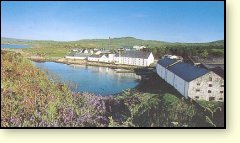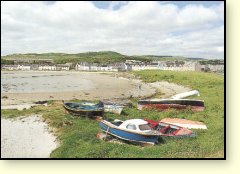
 |
|
Location: Port Ellen, Isle of Islay PA42 7DU
Roads: On A846 east of Port Ellen
Hours: Tours 10.30am & 2pm Mon - Fri; all visits by appointment
Phone: 01496-302418
Homepage: www.laphroaig.com
|
Text from The Whisky Trails, Copyright © Gordon Brown 1993:
Laphroaig is arguably the distinstive Islay malt, a pungent, primal, classy spirit that has come to embody not only the traditional style associated with the island but also the smell and earthy impact that the rest of the world regards as the essential persona of Scotch malt whisky. Before single malts were properly marketed in bottles, it was Laphroaig that the pundits had in mind when they said that consumers could not cope with such a thrusting, uncompromising whisky, and that they would have to be weaned on to it via the gentle Obans and Dalwhinnies of the world. How wrong they were!
The Johnston family were farmers and distillers on Islay and John Johnston, who founded Laphroaig around 1812, while his brother ran the neighbouring Malt Mill distillery (the forerunner of Lagavulin) from 1816. In a gruesome accident in 1847, Donald, son of founder John, drowned (or was scalded to death) when he fell into a vat of burned ale, the boiled-up lees left behind after the first distillation in whisky making.
In 1837 yet another distillery was established immediately next door on the same coastal stretch. It was called Ardenistiel or Kildalton and two of the brothers Stein, a well-known distilling family in central Scotland, were brought in to run it. A third brother, Robert, had invented the first successful continuous still just 10 years before. Ardenistiel was later incorporated into Laphroaig when it failed, largely due to the neglect of the manager who was more interested in using the kilns to produce smoked ham during the distillery’s silent season. He installed 2,000 pigs to graze on Texa islet just offshore from the distillery but that venture, too, failed and he went bankrupt.
In 1908 two Johnston sisters inherited and when they died in 1926 it was left to Ian Hunter, Isabella’s son.
In a staff photograph taken in 1934, a secretary called Bessie Williamson, actually a Glasgow chemistry graduate, is seen standing beside a Laphroaig cask. She became company secretary and in 1954 the business was left to her. She was not the first lady-distiller in Scotland but at that particular time she was believed to be the only one; Bessie went on to become a respected and important figure in the Scotch whisky industry. She retired as managing director in 1972 and went to live in Ardenistiel House.
Laphroaig has its own peat source on a bog near Port Ellen airfield. The peat is cut and stacked each April, collected in August for storing and drying before being used during the following distillation season. The pair of stills installed in 1882 was augmented with a second pair – exact replicas – in 1923, two more in 1968 and then a single additional spirit still, making seven in all, in 1974. The lyne-arms at the top of the stills rise just above the horizontal in conducting the distillation vapours towards the condensers. When a new distillery boiler was ordered in 1955, it was delivered by being floated from the transport ship to the shore.
Laphroaig still operates its floor maltings, a rarity nowadays in the rest of Scotland, but a feature of Bowmore and Laphroiag distilleries. The barley is steeped for two days then spread out on the maltings floor for seven days, where it is hand-turned every eight hours using flat wooden shovels called shiels.
Part of Laphroaig’s particularity is its medicinal aroma – first-time tasters are often reminded of iodine, cough mixture or disinfectant – and this helped it sell in the US during Prohibition – to the extent even of being made available on medical prescription.
The Whisky
Text from The Whisky Trails, Copyright © Gordon Brown 1993:

When Laphroaig distillery was first built, the small fishing town of Port Ellen provided a route for distributing the spirit.
|
Laphroaig is normally available at 10 and 15 years old, at 40% and 43% vol.
Recent bottlings include 10 year old cask strength at 57.3% and a 18 year old called Vintage 1977. This, and a 20 year old called Vintage 1976 are available only through duty free outlets and at the distillery.
A 30 year old Laphroaig has just been made available for 1977 release.
Source of water
Kilbride river